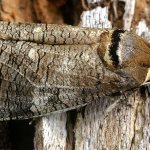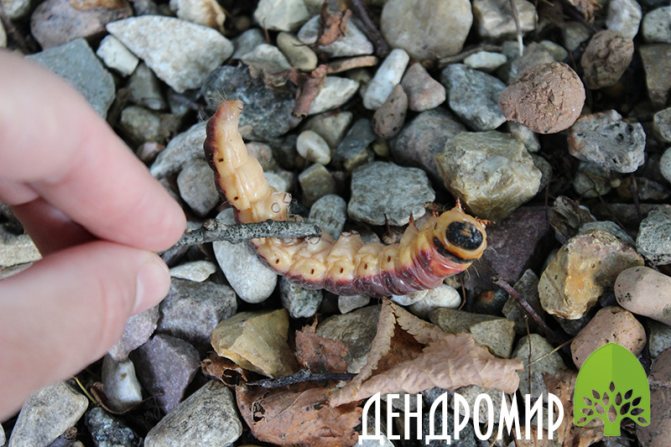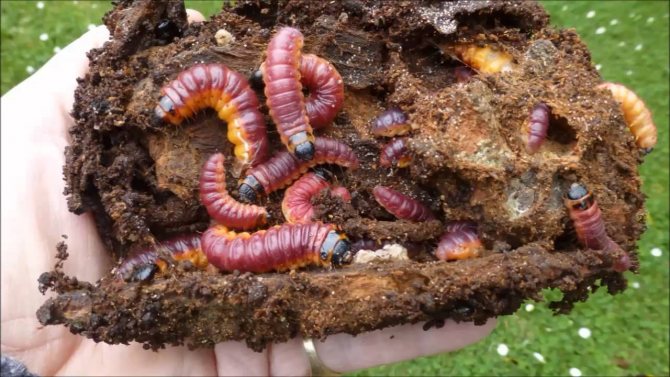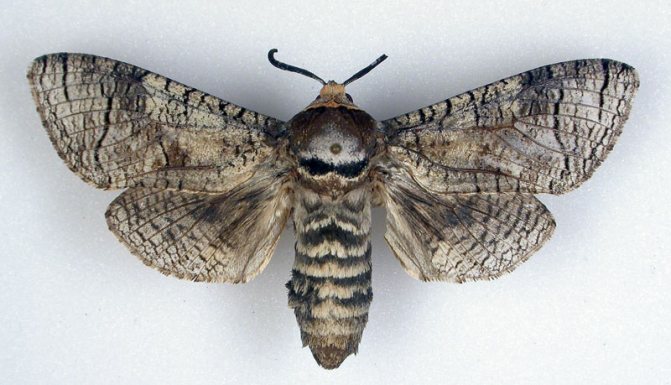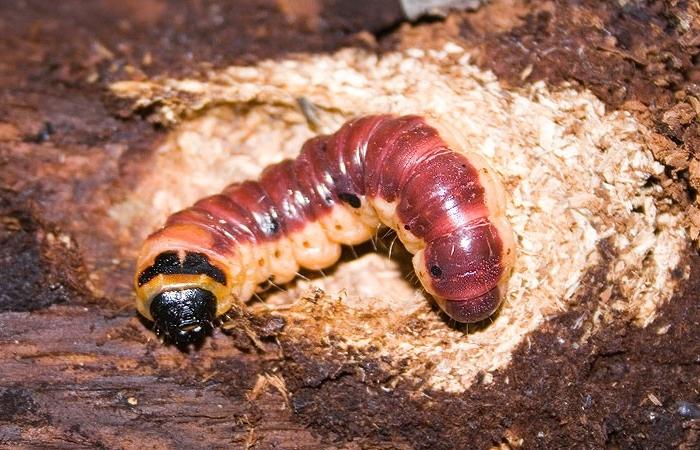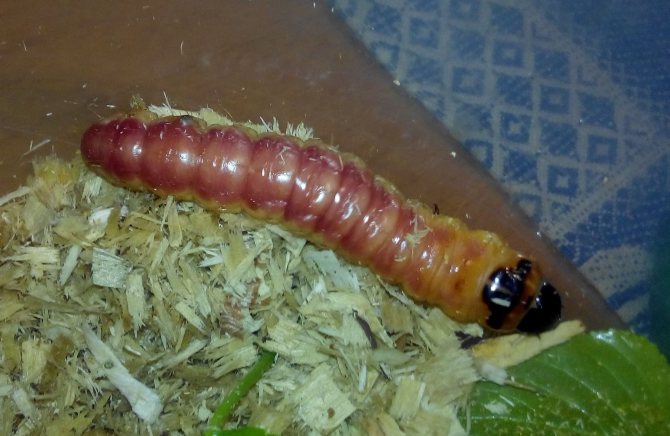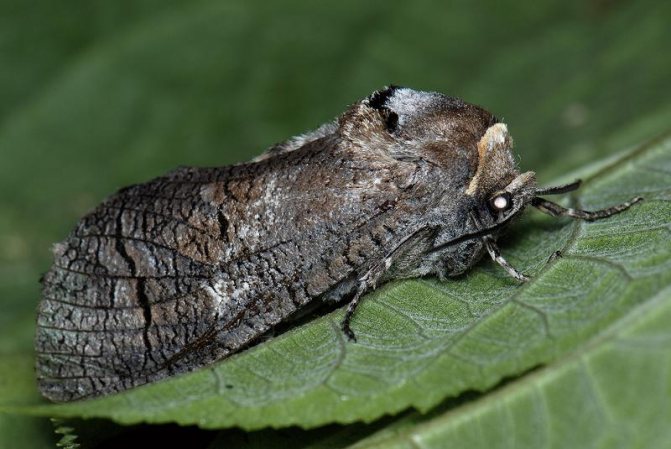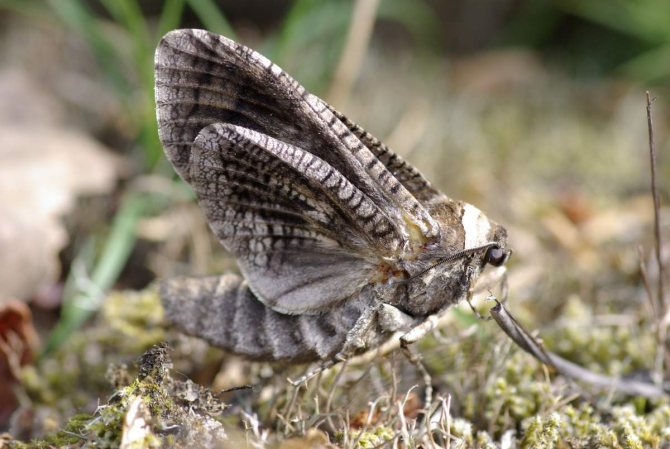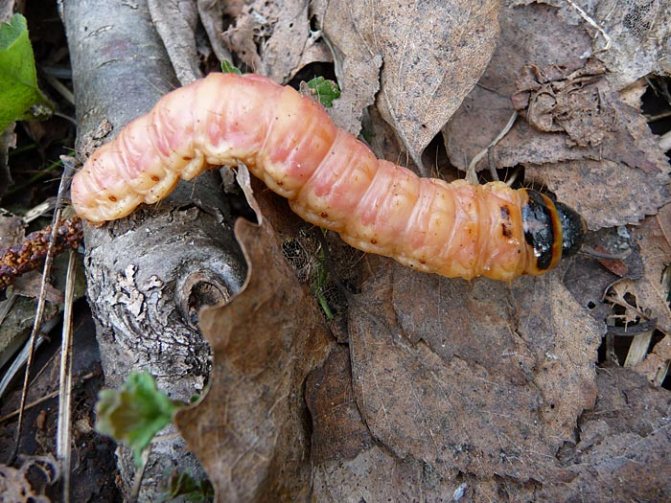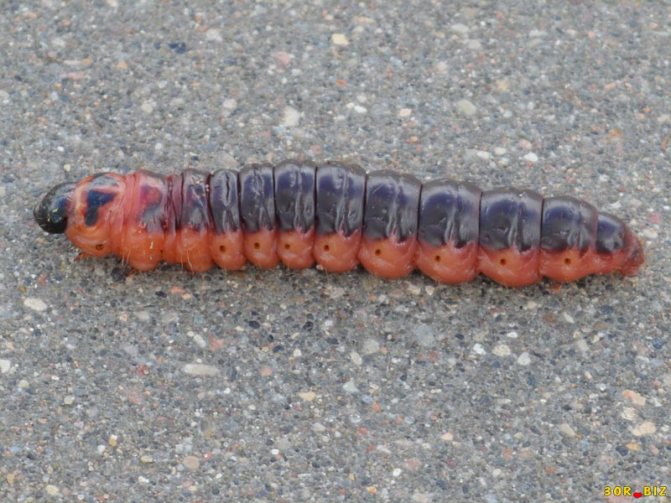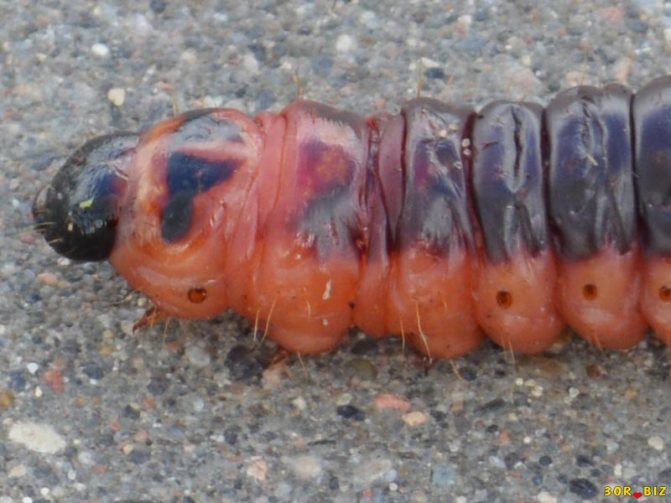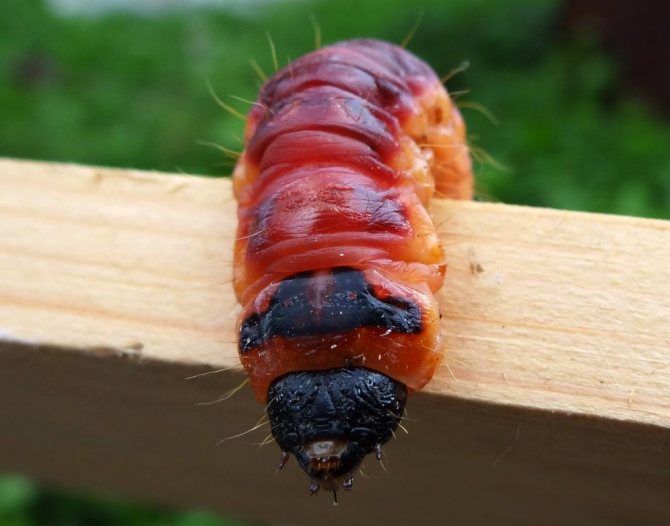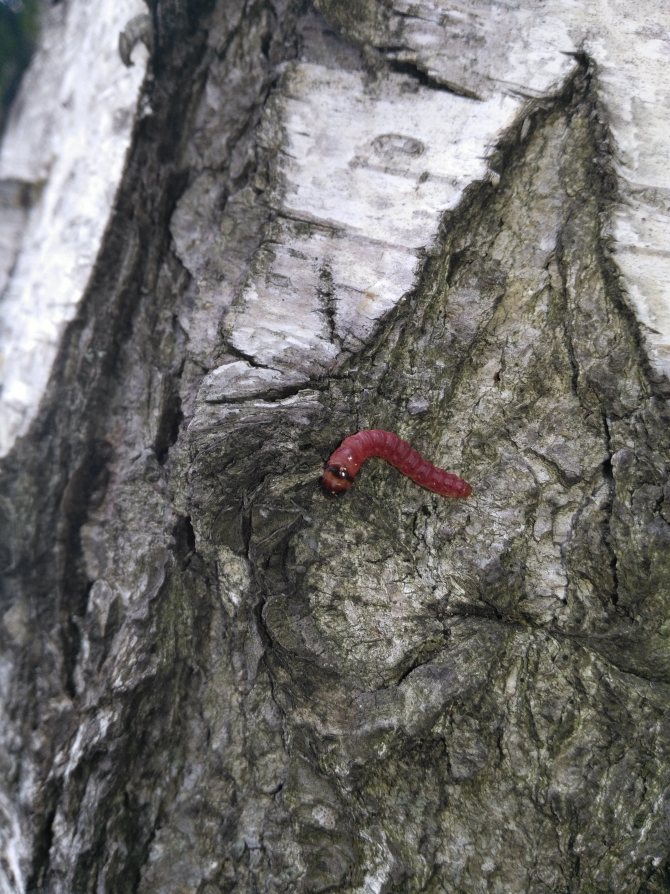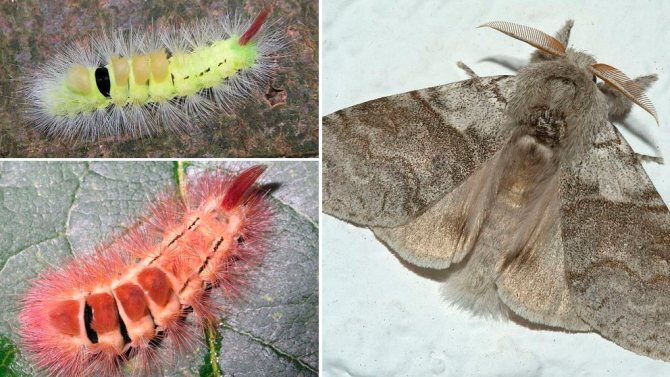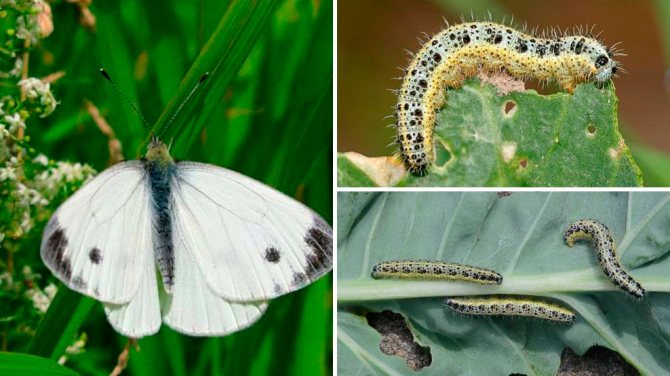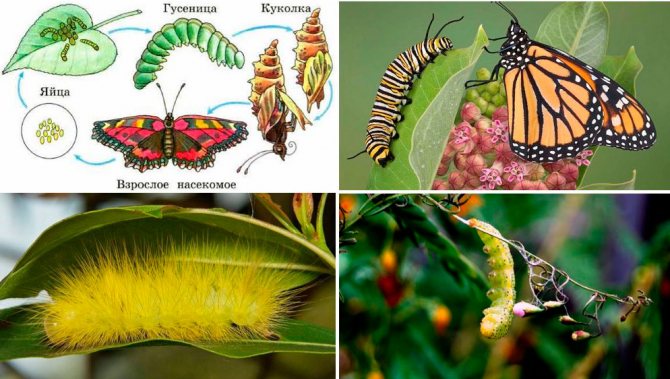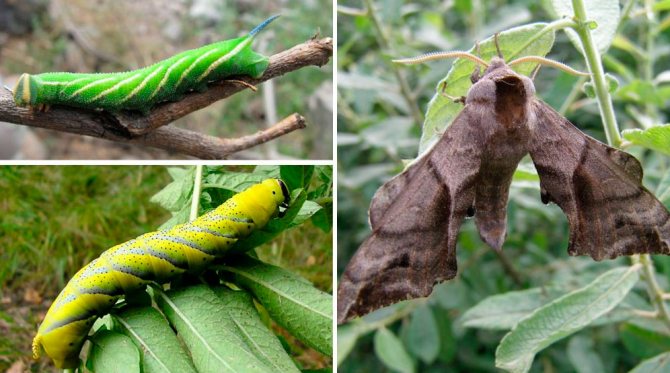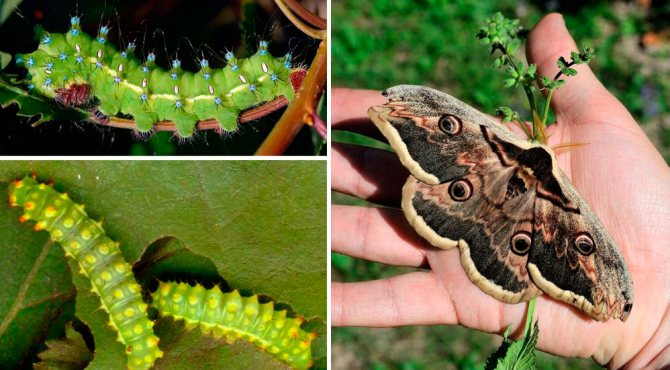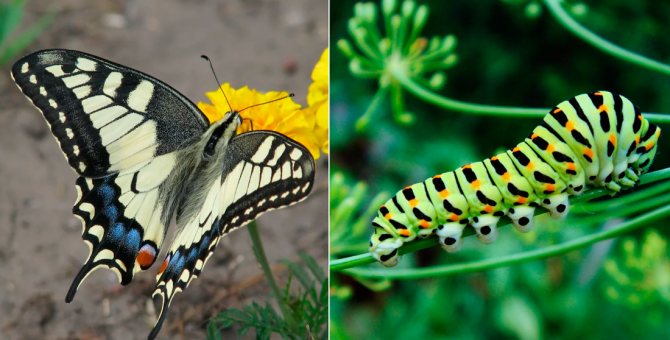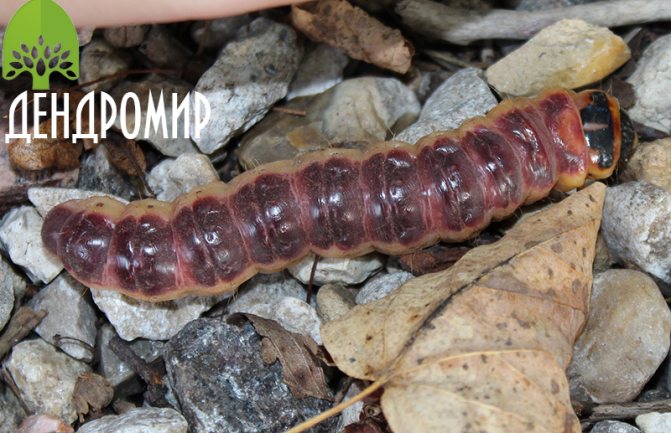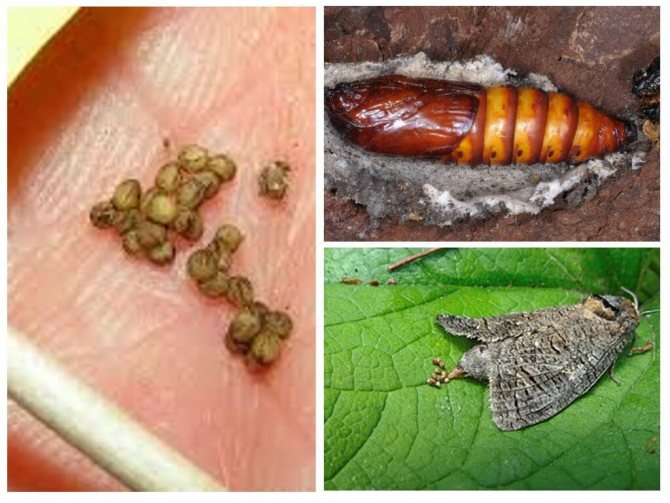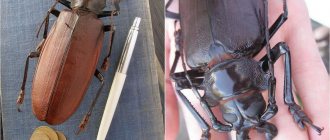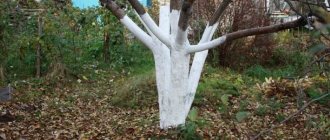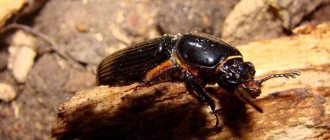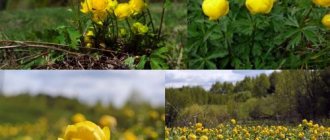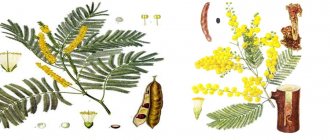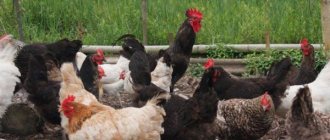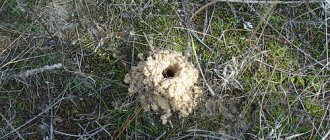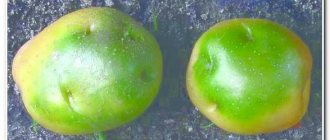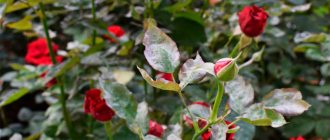Description of fragrant woodworm
The butterfly of this species reaches impressive sizes: the wingspan of the female is 100 mm, that of the male is 70 mm. The color on different parts of the body is different:
- Forewings can be of all shades of gray (sometimes with brown tint) with a fuzzy gray-white marble pattern, or dark wavy lines located across the wing.
- The hind wings have a deep dark brown shade, on top of which there are matte lines several shades darker.
- Chest - closer to the head, brown, with a velvety black stripe running across. Near the abdomen, the shade becomes paler.
- The abdomen is dark gray, with clearly visible light gray scales.
In adult females, the retractable ovipositor is clearly visible, they are larger and thicker. The body and wingspan of the male is much smaller. Both individuals have a short, underdeveloped proboscis. The entire body of the scent moth butterfly is covered with short hairs.
The eggs of this pest are elongated, reaching up to 1.5 mm in length. Their color is light brown with dark gray stripes. The larvae (or caterpillars) after hatching reach impressive sizes - up to 80 mm in length and up to 12 mm in thickness. Their body is deep red in color, subsequently it changes its shade to yellowish red. The head and dorsal plates are black. Caterpillars have a powerful jaw that can bite through human skin.
The peculiarity of this species is the pungent smell of wood vinegar, perceptible at a distance of several meters.
The dark-brown pupae of the smelly woodworm are in cocoons made of wood stubs. Their size reaches 30 mm.
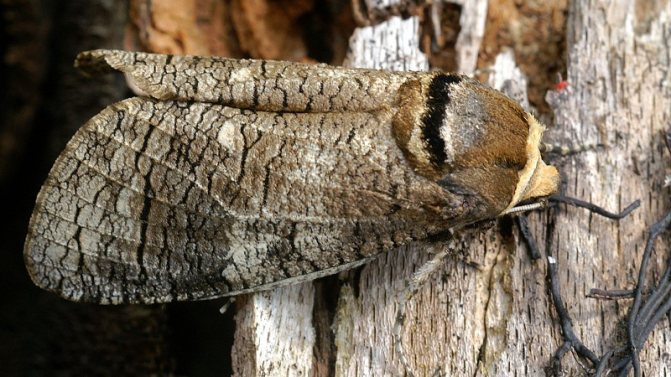
What kind of caterpillar?
A large nondescript butterfly, similar to a night moth and, similarly with it, leading a nocturnal lifestyle, can become a rather large nuisance for the garden. And it's not even really about her.
And the fact is that a large pink caterpillar hatches from the egg that is laid by this very butterfly with the picturesque name Woodworm smelly, and not one, but a thousand, since the clutch of eggs is about 1000 pieces.
The odorous tree borer (Latin name Cossus ligniperda Fr.) is widespread throughout Russia. This caterpillar is quite harmful to some deciduous tree species.
Caterpillars hatch soon enough, eat up the top layer of wood - sapwood, and sink under the bark, where they calmly spend their first winter.
Interestingly, the woodworm caterpillar changes color as it matures. Now this caterpillar becomes pink only on the abdomen, and its back becomes brownish red. An adult caterpillar, covered with sparse hairs and reaching a length of 10 cm.
What is the reason for the sweet and unpleasant odor from pear, apple, poplar, willow, alder? ... This is a pest - drevotochets. In addition to its color and unusually large size, the woodworm caterpillar has another distinctive feature. It gives off a strong smell of wood vinegar.
Moreover, the smell emanating not only from a living caterpillar, but also from a mummified one is strong enough. It can even determine that the tree is affected by woodworm.
On numerous gardening forums on the Internet, many users are interested in the cause of the smell from trees. Here is the answer - a pungent vinegar smell exudes a woodworm caterpillar. And, if there are a lot of caterpillars, then the smell from them is heard even at a distance of several meters from the tree. However, it may be too late to save the tree.
The fact is that initially the butterfly lays its eggs, choosing sick, weakened trees. If single specimens survive, then the tree is not in danger. If they develop in large quantities under the bark, then they can destroy the tree quickly enough. And the reason for this is that the fact of infection is detected quite late.
Well, it is not customary to sniff trees in our country in order to identify woodworms. But, if there are holes on the trunk, the exit from which is covered with drill flour and tree sap is released, then this is it. Unfortunately, in the later stages of infection (when the leaves dry out and most of the crown flies around), it is already useless to fight the caterpillar.
It is important to avoid contamination of surrounding trees.
The caterpillar hibernates under the bark twice, making long longitudinal passages in the wood from the bottom to the top of the trunk with transverse galleries, disrupting the sap flow.
At the beginning of the third summer, the caterpillars pupate and are located in the immediate vicinity of the exit to the surface.
The pupa period lasts from two weeks to one and a half months, after which a full-fledged butterfly leaves the bosom of its native tree. Sometimes the woodworm caterpillar looks for another place for pupation.
Independent measures to control woodworm are not very broad. If you saw characteristic holes on the trunk or realized that the reason for the vinegar smell from woody plants is a lesion by a woodworm caterpillar, then you can take the following measures to combat the caterpillars:
- It is especially important to spray trees from the second half of June to August with poisons (rimon, confidor Maxi, confidor, arriva, sherpa). You should remember about your own safety measures. It is better to entrust spraying with poisons to specialists.
- If it is possible to make a tip for the sprayer, then try to pour the poison directly into the holes.
- You can coat the trees with a mixture of mullein and clay before the butterflies fly.
- In the literature, there is another method - to insert pieces of cotton wool dipped in carbon disulfide into the holes.
If you can't cope with woodworm on your own, call us, we will help you!
Range and habitat
Europe (Eastern and Western), the mountains of the Caucasus and Western Siberia are considered to be the habitat of the odorous woodworm. Occasionally, the insect can be found in North Africa and Asia Minor.
The main habitat is mixed and deciduous forests, trees located in river floodplains, gardens and parks in cities. The Caucasus Mountains are inhabited by this insect up to the upper border of the forests. In zones with a hot and arid climate, the woodworm lives in lakes or in the floodplains of rivers, and is predominantly nocturnal.
Subspecies
- Cossus cossus cossus
- Cossus cossus albescens
Kitt, 1925 (Kazakhstan, Russia) - Cossus cossus araraticus
Teich, 1896 (Azerbaijan, Georgia, Turkey, Iran) - Cossus cossus armeniacus
Rothschild, 1912 (Turkey) - Cossus cossus chinensis
Rothschild, 1912 (China: Shaanxi) - Cossus cossus dauricus
Yakovlev, 2007 (Russia: Transbaikalia) - Cossus cossus dersu
Yakovlev, 2009 (Russia: Primorsky Krai) - Cossus cossus deserta
Daniel, 1953 (Mongolia) - Cossus cossus gueruenensis
Friedel, 1977 (Asia Minor) - Cossus cossus kopetdaghi
Yakovlev, 2009 (Turkmenistan) - Cossus cossus kossai
Wiltshire, 1957 (Jordan, Iraq) - Cossus cossus lucifer
Grum-Grshimailo, 1891 (Tibet) - Cossus cossus mongolicus
Erschoff, 1882 (Mongolia) - Cossus cossus omrana
Wiltshire, 1957 (Iraq, Iran) - Cossus cossus tianshanus
Hua, Chou, Fang & Chen, 1990 (Kazakhstan, Kyrgyzstan, Uzbekistan, Tajikistan, Afghanistan) - Cossus cossus uralicus
Seitz, 1912 (Uralsk)
Life cycle
The life of this insect consists of four stages: an egg, a caterpillar, a pupa and a butterfly.
Egg
Adults lay eggs in late June and early July. They are placed in cracks and cracks in the bark of trees. The laying of eggs is carried out in several passes; the female pours each portion with a rapidly hardening liquid. During its life, a butterfly can lay up to 1000-1300 eggs. This stage of the cycle lasts 10-12 days.
Caterpillar
Young hatched caterpillars live together, this is necessary for obtaining food and joint cutting of passages under the bark of trees.
The caterpillar burrows are filled with red-brown excrement.It is for them that the pest can be detected.
Caterpillars hibernate twice in their life. For the first time - under the bark, with the onset of spring, they wake up and begin to more actively gnaw through independent passages towards the center of the trunk. After the second winter, some of the caterpillars leave the tree and crawl over the surface of the earth in search of a place for pupation.
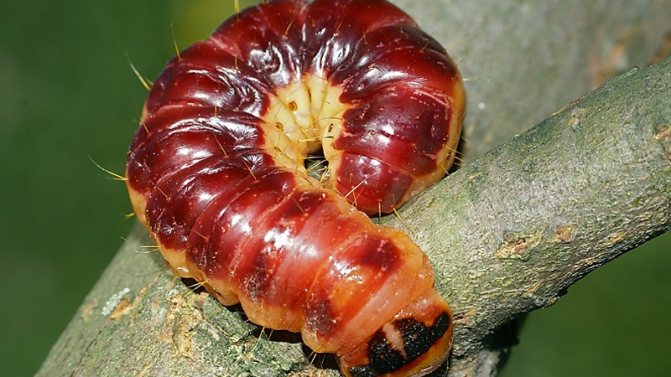

Chrysalis
Pupation occurs at the end of May, in the second year of the caterpillar's life. The cocoon is made up of pieces of bark, soil, and silk filaments produced by the larva. Its location is soil, stumps or tree bases. The pupation phase lasts for one month.
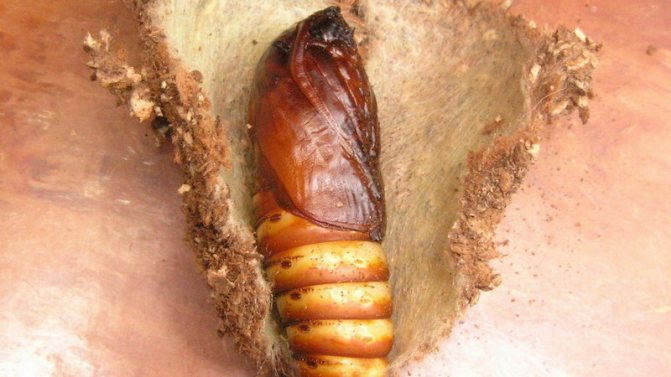

Butterfly
Butterflies live in July-August. They are especially active in the evening, after sunset. Females lay eggs in crevices of bark and wood, fill them with a sticky, quickly solidifying substance. They do not need food to reproduce. The number of eggs laid can range from 250 to 1300; on average, each butterfly lays about 1000 eggs.
Lonomia Obliqua
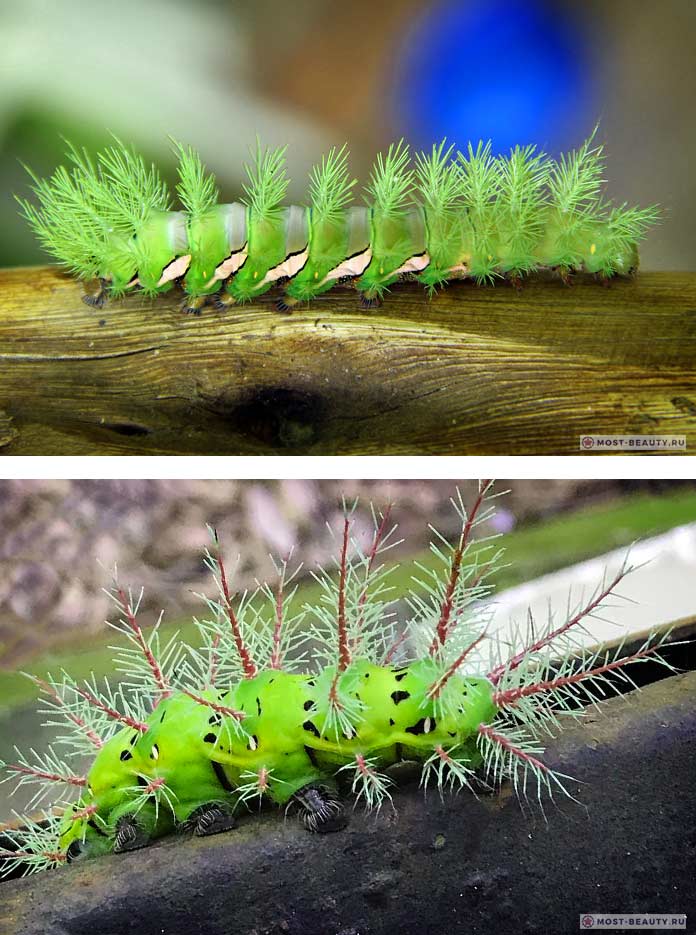

One of the most venomous caterpillars on the planet is the larva of the Peacock's Eye butterfly, found in Latin America. Reaches a length of 5.5 to 8 cm. The whole body is covered with fine hairs. They are also called the Lazy Clown.
Numerous studies have shown that Lomonoso can produce toxic substances that are dangerous to human life and health. They first drew attention to toxin poisoning in 1983, when dangerous creatures caused a massive epidemic in the Brazilian state of Rio Grande do Sul.
A poisonous caterpillar from South America has caused the death of many people. Especially often deaths after meeting with her are recorded in the south of Brazil.
14
What eats
The basis of the diet of the odorous woodworm is deciduous species that grow both in the garden and in the forest:
- willow;
- poplar;
- oak;
- alder;
- aspen;
- Walnut;
- Apple tree;
- pear;
- Rowan;
- Linden;
- white acacia.
Caterpillars feed on bark and wood itself, making tunnels and holes in the trunk.
Most often, the pest damages softwood species or trees growing alone, as well as weakened and diseased plants.
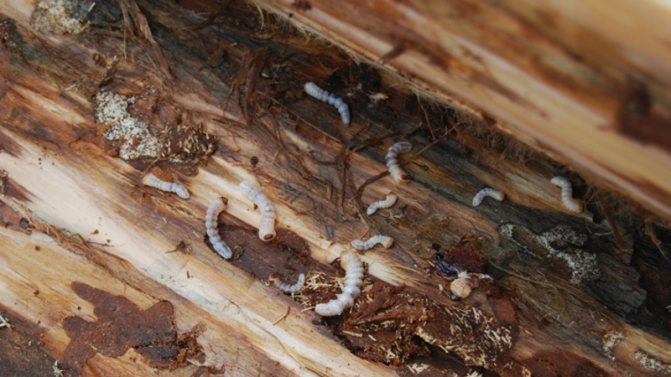

XILIX® Gel fungicide and insecticide in one bottle with a 10-year guarantee!
XILIX® Gel is an innovative development for the fight against any wood pests such as longhorn beetles, grinders, shashel, wood borers, etc. It is also an effective professional biocidal agent that effectively destroys mold, fungus, copes with rot and wood defects.
Indispensable for the prevention and treatment of wooden structures.
• Destroys termites, grinder beetles, bark beetles, woodworms, longhorn beetles, etc. • Economical and easy to use • Safe for people • Strengthens the structure of the tree • Ready to use, the gel does not flow, does not leave marks • Penetrates deep into the tree
XILIX® Gel is a superior, safe alternative to phosphine gas fumigation with a guarantee for 10 YEARS! High efficiency is achieved thanks to well-chosen components of the gel. Biocides and permethrin in the composition give a fantastic insecticidal and fungicidal effect.
Due to its thixotropic formulation, the gel works without loss of properties and in a thick layer of wood, thereby reducing the number of applications to obtain the required therapeutic or prophylactic dose of the gel.
The harm caused by odorous woodworm
The main damage to trees is caused by caterpillars. Immediately after hatching from eggs, they get to young shoots and penetrate inside, to the core. As it grows, the pest's moves increase in length, first horizontally, damaging blood vessels and weakening the tree, then down to the base of the trunk.
A tree affected by woodworm loses its attractiveness: mass shoots die, leaves in the crown dry up and fall off.In fruit crops, the yield is sharply reduced. The tree becomes weakened and cannot withstand fungal and bacterial diseases. In the absence of measures aimed at exterminating the pest, it completely dries up and dies.
Sweetheart / Orgyia leucostigma
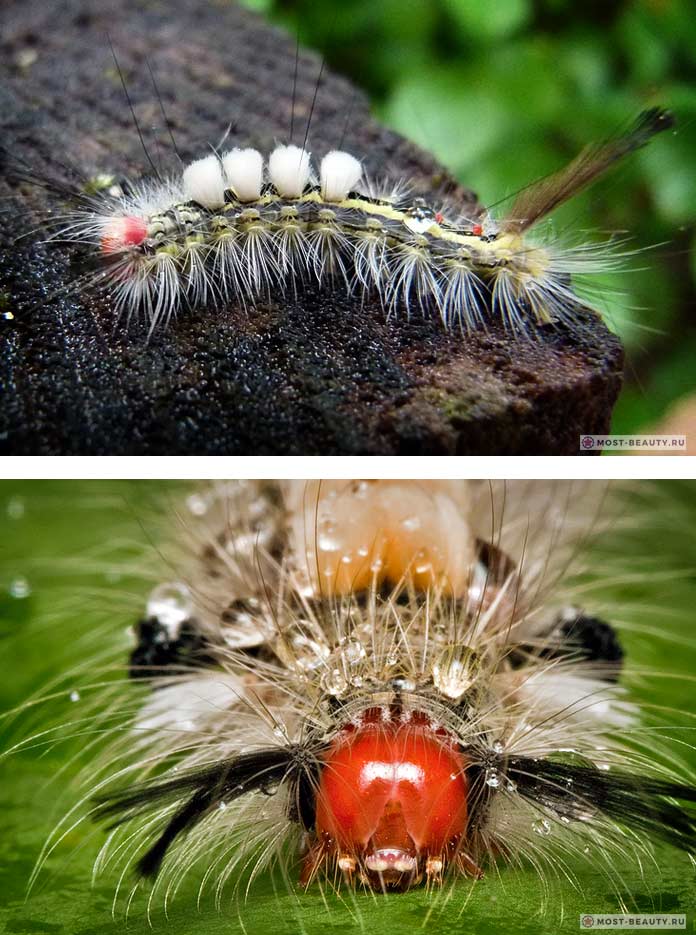

Small butterflies have settled on all continents, and in total there are more than 2,700 species. Especially large populations are found in the tropical and subtropical zones of Southeast Asia and the African continent.
Caterpillars are venomous in many species of Volpianus. On the body there are hairs containing a poisonous substance. During periods of mass reproduction, such larvae can cause great harm to animals and humans. The poison causes inflammation of the respiratory tract, affects the mucous membrane of the eyes and causes a rash on the skin.
In addition, they are polyphagous and cause great harm to garden and park crops. They develop both on trees and on shrubs and herbaceous plants.
6
Signs of the settlement of the territory by woodworm
The population of this pest can be identified by the following criteria:
- juice found in the lower part of the trunk;
- a strong and persistent smell of wood vinegar, which is felt next to the tree trunk;
- wide, oval-shaped passages on branches and bark;
- drill meal on the surface of the bark. It looks like small brown or yellow sawdust;
- changes in the appearance of the tree: dried branches, bark lagging behind the trunk, falling leaves.
In some cases, the pest can be detected by caterpillars migrating along the ground to the place for pupation.
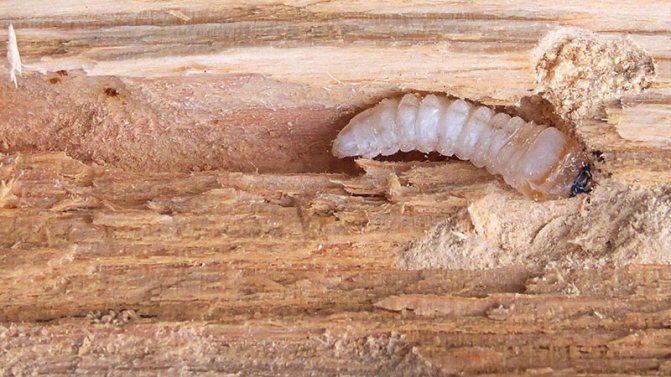

Control measures and prevention
Mechanical, chemical and biological control measures are used to exterminate the odorous woodworm.
Mechanical methods
This method consists of removing dead bark from trees and manually collecting larvae. When working, do not use metal or plastic tools, as they can easily damage the wood. Hands must be protected with rubber gloves. On trees, wounds and places without bark should be covered with garden varnish.
All collected larvae and damaged bark should be burned immediately after collection.
For timely detection of woodworm, the trunk and crown of garden trees should be inspected at least once a week, throughout the entire period from June to September. If there are damaged young shoots, they should be cut off. Severely affected specimens must be uprooted and burned.
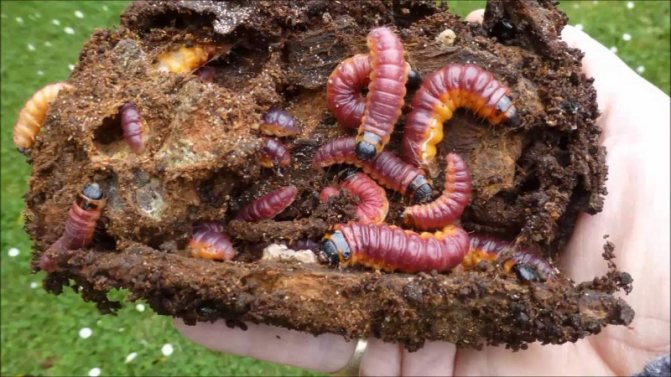

Chemical control measures
Organophosphate insecticides have shown their effectiveness in the fight against woodworm:
- Actellic.
- Diazinon.
- Karbofos.
- Chlorophos.
- Chlorpyrifos.
The method of use is to soak a cotton ball in the insecticide and place it in the pest's stroke. Also, you can inject the drug into the hole from a syringe.
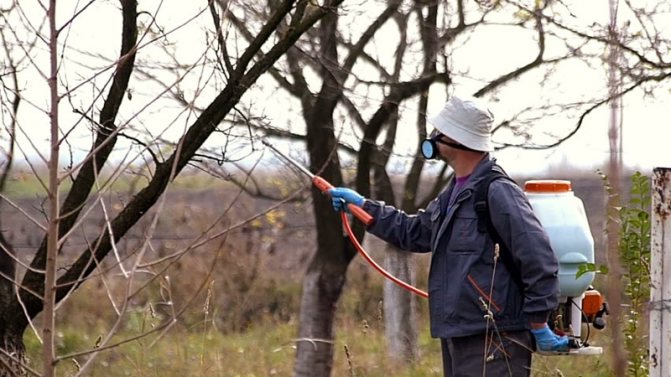

Biological methods
This method includes attracting birds to the site, the diet of which includes insects. First of all, these are tits, woodpeckers, magpies and rooks. You can increase the number of birds by hanging feeders, houses and artificial nests in the garden.
Prophylaxis
To prevent the growth of the woodworm population, it is necessary to regularly remove dead bark and overgrown moss from the trunks. Cover bare places with one of these compounds:
- Clay with lime, mixed in a 2: 1 ratio.
- Clay, glue and insecticide. To prepare the paste, you need to mix 1 kg of clay with water until the consistency of sour cream, add 250 g of wood glue and 90 g of 10% karbofos.
When processing young plants with uncorked bark, it is not recommended to add glue to the composition.
Paste treatment should be carried out twice a year: in the spring - after the snow melts and in the fall - after the leaf fall. Paste application height - up to the growth points of skeletal branches, not less than 2 m in height.
Fragrant woodworm is a dangerous pest of deciduous trees, common in Russia and neighboring countries.The caterpillars of this insect can completely destroy both forest green spaces and fruit trees in the garden.

